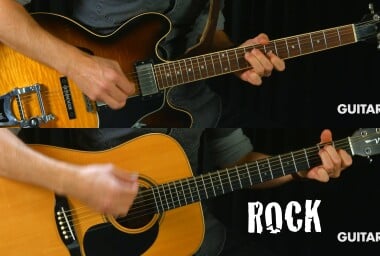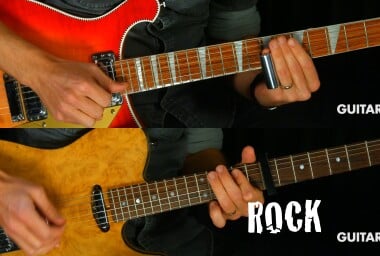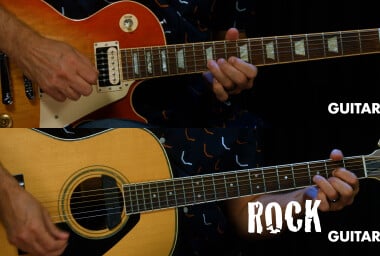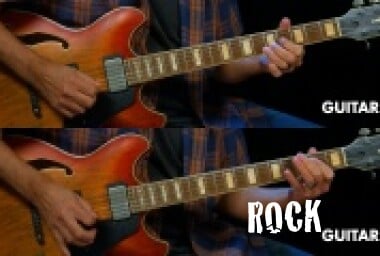The Rolling Stones Songs

Anders will show you the 2 electric guitar parts in this song. Guitar 1 plays a simple but effective chord progression and riff that drives the song. Guitar 2 plays another very simple, but highly effective single note guitar part that dances around between the vocal and the rhythm part. This song uses open chords, barre chords, simple single note melodies and chord arpeggiation.
Published: 09/25/2020 UpgradeAnders will show you how to play the acoustic guitar part that works just as well around a campfire by itself as it does on a big stage with a full band. On top of that is a very iconic slide guitar, riffing more or less throughout the whole song, dancing in between the vocal phrases.
Published: 02/17/2021 UpgradeAnders will show you both guitar parts to this song. Guitar 1 is an acoustic rhythm guitar that drives the groove throughout the whole song. Guitar 2 is an electric guitar that alternates between playing cool rhythmic chord stabs and single note lines that delicately toe the line between a rhythm and a lead part. The electric guitar also plays a solo in the middle of the song.
Published: 03/17/2021 UpgradeAnders will show you all three guitar parts in this classic early rock song. There's a driving acoustic rhythm guitar, strumming the basic open chords. There's an electric rhythm guitar that plays the main riff during the whole song, as well as chords during the choruses. Finally there's the reverb-effected electric lead guitar, which only comes in for the solo.
Published: 02/10/2021 UpgradeAnders will show you how to play an acoustic guitar part through the song since there isn't a guitar part in the original song until the super bright and iconic lead guitar comes in about halfway through. Playing the acoustic guitar part will help you play this song by yourself or with a band. Once the solo comes in he will break down every note played.
Published: 03/10/2021 UpgradeAnders will show you how to play this classic Rolling Stones song. Guitar 1 is an electric playing the classic main bluesy riff of the song. Guitar 2 plays the signature slide part. And for the first couple of verses everything is fairly straight forward until several dramatic changes in the rhythmic groove.
Published: 02/24/2021 UpgradeAnders will show you how to play this classic tune on an acoustic guitar. The original only had a 12-string acoustic playing during the chorus. Anders will show you how to adapt that part for a regular 6-string acoustic. There's a part that fits with the orchestral part, but can also stand on its own if you ever want to play this song by yourself.
Published: 03/03/2021 UpgradeMike will show you the 2 guitar parts in this song. Guitar 1 is an acoustic guitar that strums the chord progression throughout. Guitar 2 is a clean electric guitar that adds some slide and ornamentation throughout. In the following lessons, we’ll talk about open chords and barre chords, chord arpeggiation, slide guitar, and octaves. We are in the key of E minor, with a 4/4 time signature, at a tempo of 202 BPM.
Published: 07/01/2021 UpgradeMike will show you the 2 guitars in this song. Guitar 1 is a slightly overdriven electric guitar tuned to open G that plays the rhythm riffs throughout. Guitar 2 is an overdriven electric guitar that adds some light ornamentation, a tasty slide solo, and an extended outro solo featuring some textbook bluesy rock approaches.
Published: 08/05/2021 UpgradeDave will show you the single acoustic guitar part in this classic 60 pop rock song. The part features delicately finger-picked chords, melodies, and bass notes. This song is in the key of E minor and 4/4 time at a tempo of 110 BPM.
Published: 11/12/2021 UpgradeMike will show you the 2 guitar parts in this song. Guitar 1 is an acoustic guitar that strums the progressions throughout and adds some single note lines in the second verse. Guitar 2 is a clean electric guitar that adds backbeat chord stabs to the arrangement. This song uses open chords, a steady strum approach, backbeat chord stabs, and dynamics.
Published: 11/24/2021 UpgradeThere are 2 guitars in this song. Guitar 1 is an acoustic guitar that strums the chord progressions throughout. Guitar 2 is a clean electric guitar that adds some country influenced licks and fills all through the song. This song uses open chords, a steady strummed approach, and some textbook country influenced licks.
Published: 06/16/2022 UpgradeThere are 2 guitars in this song. Guitar 1 is an acoustic guitar with a capo on the 3rd fret that strums the chord progressions throughout. Guitar 2 is a clean electric guitar that adds a bluesy solo and some lead fills in the outro. This song uses a capo, open chords, steady strummed approaches, and some bluesy licks.
Published: 11/10/2022 UpgradeThere are 2 electric guitars in this song. Guitar 1 is a clean guitar that plays rhythm throughout, while Guitar 2 adds some bluesy licks to the second half of the tune. We’ll also adapt the Mellotron lines heard in the outro to Guitar 2. This song uses aggressive syncopated strumming, seventh chords, and bluesy leads.
Published: 12/03/2022 UpgradeThere are 2 electric guitars in this song. Guitar 1 is an overdriven guitar that starts the tune with a lick, then plays a rhythm riff throughout the rest of the tune. Guitar 2 is a clean guitar that plays a solo and sprinkles a few fills into the arrangement. This song uses bluesy rhythm riffing, a triplet swing groove, and some simple blues leads.
Published: 11/23/2022 UpgradeThere are 2 clean electric guitars in this song. Guitar 1 plays the rhythm riffs throughout the tune, while Guitar 2 is a clean guitar that plays a solo and some fills. This song uses bluesy rhythm riffing, hybrid picking, a triplet swing groove, and some simple blues leads.
Published: 12/08/2022 UpgradeThere are 2 guitars in this song. Guitar 1 is a clean electric guitar that plays lead and rhythm throughout, while Guitar 2 is the acoustic guitar that strums a steady foundation. This song uses# arpeggiated riffing with pull offs, steady strums with a waltz feel, open chords, and some bluesy lead approaches.
Published: 01/03/2023 UpgradeThere are 2 acoustic guitars in this song. Guitar 1 strums the chord progressions, while Guitar 2 adds chord arpeggiation and embellishments throughout. Any acoustic guitar can be used to play this song, but one with a brighter tone will help cut through the mix a bit better. Also, a capo is needed on the first fret to strum the chord progressions. This song uses open chords, steady strumming approaches, and chord arpeggiation.
Published: 02/10/2023 UpgradeThere are 2 electric guitars in this song. Guitar 1 is tuned to open D tuning and strums the rhythm riffs throughout. Guitar 2 is the lead guitar that adds plenty of licks to the tune. This song uses open D chord shapes and embellishments, and some killer bluesy licks.
Published: 02/16/2023 UpgradeThis song features one acoustic guitar tuned a full step down from standard tuning. Any acoustic guitar can be used to play this song. This song uses open and barre chords, chord arpeggiation, 3/4 time, and dynamics.
Published: 03/16/2023 UpgradeThis song features one acoustic guitar that strums and arpeggiates the riffs throughout. Any acoustic guitar can be used to play this song. This song uses open chords, chord arpeggiation, aggressive strumming, and dynamics.
Published: 04/06/2023 UpgradeThere are 2 clean electric guitars in this song. Guitar 1 plays the rhythm riffs throughout the tune, while Guitar 2 is a clean guitar that plays licks in the intro and solo sections. This song uses bluesy rhythm riffing, a triplet swing groove, and some simple blues leads.
Published: 03/02/2023 UpgradeThere is 1 slightly overdriven electric guitar strumming chords and riffs throughout the tune. The guitar is tuned to open D tuning. This song uses open D chord shapes and embellishments, and some steady strummed approaches.
Published: 09/07/2023 UpgradeThere is one electric guitar strumming the chord progressions throughout, as well as adding some fuzzed-out bluesy licks to the solo section. This song uses barre chords, steady strum approaches, and some killer bluesy rock lead approaches.
Published: 04/13/2023 UpgradeThere is 1 electric guitar that strums the chord progressions and adds some lightning quick bluesy licks in the middle “freak-out” interlude. This song uses open chords, barre chords, and triads, steady strummed approaches, and bluesy lead approaches.
Published: 04/27/2023 Upgrade























